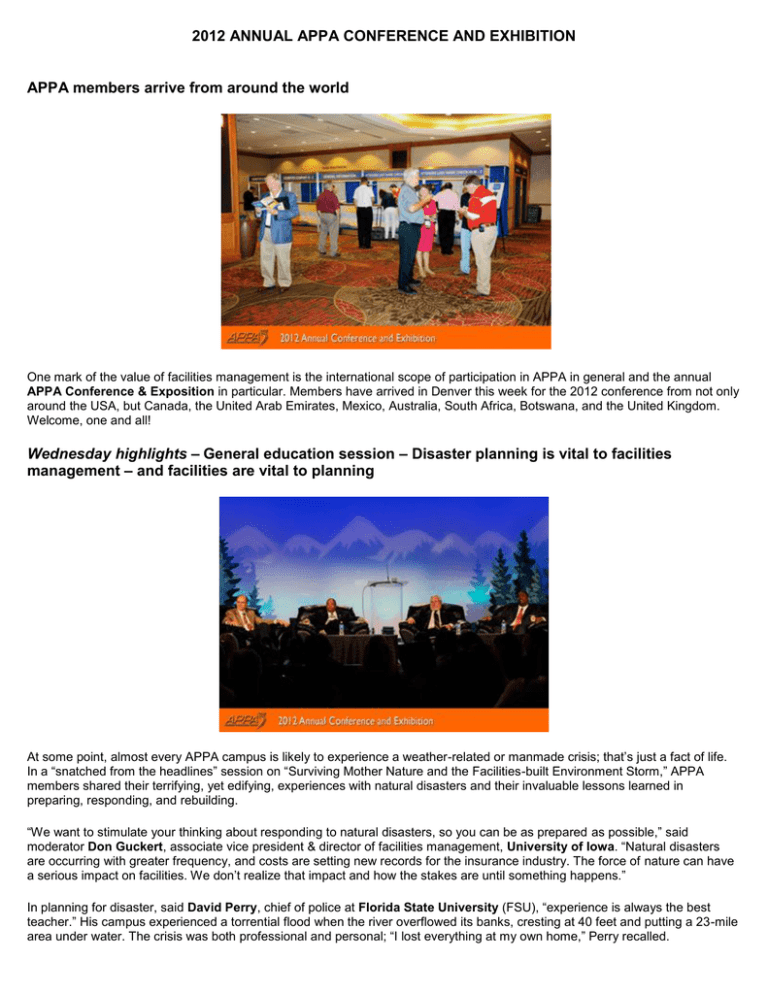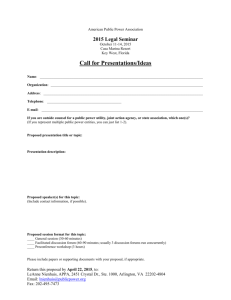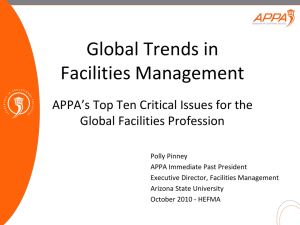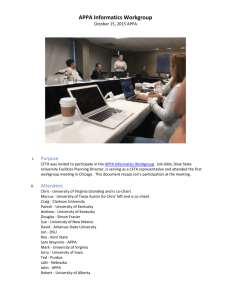2012 ANNUAL APPA CONFERENCE AND EXHIBITION
advertisement

2012 ANNUAL APPA CONFERENCE AND EXHIBITION APPA members arrive from around the world One mark of the value of facilities management is the international scope of participation in APPA in general and the annual APPA Conference & Exposition in particular. Members have arrived in Denver this week for the 2012 conference from not only around the USA, but Canada, the United Arab Emirates, Mexico, Australia, South Africa, Botswana, and the United Kingdom. Welcome, one and all! Wednesday highlights – General education session – Disaster planning is vital to facilities management – and facilities are vital to planning At some point, almost every APPA campus is likely to experience a weather-related or manmade crisis; that’s just a fact of life. In a “snatched from the headlines” session on “Surviving Mother Nature and the Facilities-built Environment Storm,” APPA members shared their terrifying, yet edifying, experiences with natural disasters and their invaluable lessons learned in preparing, responding, and rebuilding. “We want to stimulate your thinking about responding to natural disasters, so you can be as prepared as possible,” said moderator Don Guckert, associate vice president & director of facilities management, University of Iowa. “Natural disasters are occurring with greater frequency, and costs are setting new records for the insurance industry. The force of nature can have a serious impact on facilities. We don’t realize that impact and how the stakes are until something happens.” In planning for disaster, said David Perry, chief of police at Florida State University (FSU), “experience is always the best teacher.” His campus experienced a torrential flood when the river overflowed its banks, cresting at 40 feet and putting a 23-mile area under water. The crisis was both professional and personal; “I lost everything at my own home,” Perry recalled. FSU has an emergency-alert system that students can opt out of; registration is at 87%. It connects to an official website for immediate information about any current or impending threat. There also are outdoor speakers that give out a chime to alert people to a threat. “You’re never sure of where (anyone) might be on campus if an emergency strikes, so time really does matter,” Perry said. Key to success is for the campus police department and communications staff to know that they the authority to “push that ‘Easy’ button” as soon as a threat is known, because seconds count, Perry noted. It is essential to have a system in place where no time is wasted on going through torturous channels before the campus can be alerted to danger. “All our campuses will be judged on how fast we notify people,” he said. FSU has prepared and rehearsed a variety of scenarios that would mandate “pressing the button with delay,” and the school does a test of the alert system once each semester that has no info except test details. Perry urged APPA colleagues to stress the value of developing such “what if” situations and rehearsing the response to them, no matter how unlikely they may seem. “Make sure your plan works,” he said. “Test it and evaluate it.” “Planning for disaster depends on communications,” Perry noted. “You need partners in the local community – it’s too late to create those partnerships when a crisis occurs.” A campus-wide partnership with facilities is “vital,” he said. Being in the middle of a tornado event as it was unfolding was even more disastrous for his campus because it came on the heels of a week of battling a flood, recalled Guckert. That experience taught him to “plan for your next disaster, not just the current one.” A structured response and detailed emergency plan are essential, he said. Key to success is also having relations in place before the event among campus departments and with community services and organizations. “The community may have to share the campus or go through it to escape the disaster,” Guckert said. Any type of disaster can result in competition for services and resources as supplies run low and local, regional and even national infrastructure suffers – Guckert saw roads and bridges go out, for instance, as well as cellphone towers and other vital aspects of daily life, both on- and off-campus. Threats to utilities are a real concern. Be prepared to cope with not just the disaster but efforts to help, Guckert said: “You can be overwhelmed by the response; we had 3,000 people show up to help” and they all had to have accommodations, food, services, communications, and assignments. Guckert warned colleagues that “you need good information about the scope and progress of the disaster, so you can take the guesswork out of the process,” but to be prepared that accurate information is often not available. “You need a plan for evacuation,” said Guckert. A realistic focus is also important: “It’s foolish to think you can continue operations while battling a crisis.” Lessons learned by Guckert include “manage for the biggest possible disaster and supersize that plan; plan for both success and failure; and plan for regional and community aspects of a disaster – you can’t assume anything, especially whether your supply chain will function.” The devastating tornado that struck his campus hometown of Joplin taught Robert Harrington, director of physical plant, Missouri Southern State University, that disaster will strike without warning. Like something out the movie “Twister,” sirens went off but not in time to avoid the danger for most of the area. Luckily for the campus, “we had signed an agreement with the Red Cross to serve as a shelter in an emergency just three weeks before the tornado,” he said. There hadn’t been time to schedule training in Red Cross procedures, but that turned out to be a good thing for community residents: “A Red Cross shelter typically won’t let animals in, but we didn’t know that, so we set up an area where people could bring their pets.” For the many neighbors who lost everything but their beloved pets, that was a huge service to the community, Harrington said. The Red Cross connection was helpful in another way as well. “Once the Red Cross is on your campus, AmeriCorps is right behind them,” said Harrington, “We had 3,000 to 5,000 volunteers on campus every day, and AmeriCorps is still with us.” Harrington was applauded by local authorities for one of many practical responses to the disaster: When water resources were strained, he had his people pull water out of campus swimming pools to use in various buildings for flushing toilets and other sanitary needs. Harrington warned colleagues that a major disaster can mean the governor or even the president of the United States showing up on campus, which can add layers of security and organization to the recovery process. “The amount of research needed to interact with the Secret Service is phenomenal,” he said. You can’t assume that communications systems will work in a natural disaster, Harrington noted. “The tornado took out cellphone towers, and landlines didn’t always work.” Luckily, his staff carries radios, so they could communicate with each other. As with many weather-related crises, it was difficult to predict what was happening during Katrina. “The project path was 200 miles away at first, so we weren’t worried,” Bracy recalled. “Then it moved 100 miles away, and we still weren’t very concerned. It became one of the greatest disasters ever, and people are still debating whether it should be considered a natural disaster or manmade.” To make recovery easier, especially from the financial perspective, Bracy urged colleagues to document everything. “Go back and take pictures,” he said. “Make a historical record of whatever repairs you’ve made on campus.” He suggested thinking in terms of win-win: “Designate a person of knowledge to escort FEMA and insurance company representatives around campus” to make sure everything is covered and strangers to the institution understand the role and value of every aspect of the campus physical plant. That helps the money people make better decisions on behalf of the campus. “You may have to be aggressive about reimbursement,” Bracy said. “We chose to dip into our endowment (to start repairs), because it was that important to us” to get the campus back to a functional mode; it can take years to receive FEMA and insurance funds needed for that process. Bracy warned colleagues against the typical facilities mindset of “get back on campus” immediately. “Put first things first,” he said. “Determine who is willing to go back. Resist the temptation to ‘just get it done’ without documentation.” Warnings, alerts and other disaster-related communications should be kept short and simple, Bracy said. In the wake of a disaster, Bracy said, review the emergency plan and “think outside the box”: His department now has new staff that are certified in home-building. Overall, the message of this session was that facilities professionals can never be too prepared for disasters. We hope all APPA members are ready for whatever Mother Nature will throw at us. Be sure to check out APPA publications and other resources to develop effective emergency plans and approaches. We love our business partners! One of the most popular aspects of every APPA Conference & Exposition is the Hall of Resources, packed with manufacturers, vendors, and suppliers who cater to every physical plant need and interest. APPA greatly appreciates these important partnerships, and is gratified to see that our exhibitors feel the same way. Here’s what some of our valued Business Partners have to say about why they bring their products and services to the conference. Trane: Said Apple King, trade show manager, and Becky Trujillo, marketing/Pueblo plant, “What we like about the APPA Conference & Exposition is that it’s somewhat small and intimate, which gives us an opportunity to talk to facilities directors and hear about so many systems and needs.” Antron/Invista: According to Michele Weeks, marketing insight specialist with Antron, “The value of exhibiting at the APPA Conference & Exposition is … priceless!” Siemens “We feel it’s important to be here primarily to support the APPA membership and the vision of the Executive Committee,” said Steve Hoiberg, LEED, GA, global BT market manager, higher education. “It’s also critical from the perspective of being a valued member and at one with the membership. We see ourselves as being a true partner in what APPA is doing.” Campus construction in the new economy With recent trends creating a “new economy” that puts severe limitations on new building and expansion at most campuses these days, higher-education facilities professionals continue to look for ways to do more with less. “This is the new normal,” said Steven C. Thweatt of Emory University in a session on “Campus Construction in the New Economy. The good news is that “there is a day when costs (and, thus, budgets) will go back up, though, and it is coming now, although slowly. Increased cost control is being driven by the current economic reality, reduced or scarce resources, a lack of available capital, competing priorities – with academic demands taking center stage, and a focus on facilities as stewards of university assets.” In response, Emory “recreated a culture of excellence and integrity,” said Thweatt. “Our building program had been so robust that we weren’t as aggressive about getting the best value for every dollar. We improved trust and accountability (for our department), restored an arm’s-length relationship with vendors, increased vendor accountability, and improved financial transparency by doing audits.” His department mapped capital process by publishing a brochure to improve campus understanding of all the steps involved in building, maintaining, renovating, and repairing buildings and other facilities. “We improved decision-making and shortened the process and timeline,” said Thweatt; pointing out the consequences of complex, time-consuming decision-making processes can help speed things up, even in the academic environment. Thweatt and his colleagues also implement cost-management principles, such as setting realistic expectations with campus customers, which helped establish a foundation of trust and confidence in facilities; gathering and assessing actual cost data on projects; and – “most important of all” – controlling scope and project creep. “You have to put a lid on things and let your customers know what’s not in the budget,” he said. “Empower your people to say ‘no’” when asked to add to the scope of a building project. Determining whether costs are too high requires “a frame of reference” based on good data from one’s own and peer institutions, Thweatt said. “It’s always a fight when you tell people what something will cost. High expectations drive up costs,” as do high quality standards. Cost-cutting strategies that worked for Emory include renegotiating agreements and asking vendors if they can reduce costs; leveraging good relationships to influence how vendors do things, especially in change orders – “We became true partners with true transparency”; suggesting alternatives such as CM@Risk, hard bids, design/build, job order contracting, integrated project delivery, low bids (with the caveat that “the low bid is not always the best way to go”), and “aggressive pursuit of the best price point.” Partnering for sustainability awareness in higher ed Getting campuses involved in sustainability efforts is easy on one level – everyone agrees that sustainability is a good thing – and challenging on another – there are a lot of audiences to reach and educate. A partnership between Philadelphia University and Honeywell succeeded in overcoming that hurdle by developing technology tools that made it easy for the campus community to participate and benefit. The school started by working with APPA’s FPI program to make its buildings self-contained, and has been purchasing more wind energy using smart buys and utility hedging, according to the university’s Rick Waligora. “Our BTU/gross square foot and student FTE is lower than the regional average, and our students are starting to notice,” he said. “We aren’t sitting back – we’re doing energy curtailments and efficiencies – we’re working with Honeywell” to improve results. The school is looking at how to better schedule classes, organize space, and use facilities to save energy and enhance sustainability, Waligora said, including closing down building there feasible. “We leverage available resources and ‘walk the walk’ – we go into buildings to see how they’re functioning. We define sustainability “as looking at the best we can do for the long term.” Key to the effort is “understanding that human behavior and establishing an interactive sustainable culture are as important as technology for the success of sustainability and energy conservation in the campus community,” said Honeywell's Mike Kempa. “Students drive the effort – after all, they outnumber facilities, administration and faculty!” Since students are so important to the process, the university uses social media to get the word out because “that’s is how student communicate and how we can change behavior,” Kempa said. “We are using a website, social media, and a dedicate intern with a commitment of the resources needed to spread the word.” That intern, Mamta Borkar, has been the reason the program has succeeded, according to J. Thomas Becker, PE, EFP and the other university representatives. Borkar is using tools such are press releases, green forums, websites, career fairs, and more to get the word out and encourage participation. “We’re strategizing and communicating change,” Borkar said. “We designed a website portal for this program that is integrated with the university and we’re using the Windows on the World cloud function, with touch-screen kiosks throughout the campus,” she said. “A Web-based link lets us move the campaign beyond the campus community. We can add more buildings and publish real-time data from building meters in interactive charts and consolidate the information so it’s easy to see and understand.” APPA recognizes excellence and commitment among members and institutions APPA is proud to announce recipients of its 2012 awards for outstanding service to the physical plant administration profession in higher education and to the association itself, presented on Tuesday and Wednesday evening, July 17 and 18, at this year’s APPA Conference and Exposition Award Ceremony. “Why do we recognize excellence with these awards?” asked APPA Vice President for Professional Development Glenn Smith, of Bryn Mawr College. “Because awards motivate people, and because it’s the right thing to do” when colleagues, employees and volunteers go above and beyond to make contributions to their profession, association and institutions. APPA is proud to do the right thing on behalf of these outstanding colleagues. Three cheers for these outstanding colleagues and institutions! Meritorious Service Award – APPA’s highest award for individual service, recognizing members for outstanding contributions to their institutions, their profession and the association. Recipients are nominated by the membership and regions, reviewed by APPA’s Awards & Recognition Committee, selected by that committee, and approved by the APPA Board of Directors. This year’s recipients are Tony Ichsan, Mark Hunter and Brian Worley. Sustainability Award – APPA’s newest award, introduced at APPA’s 2011 conference; recognizes and advances sustainability excellence in educational facilities; presented to a facilities management department that integrates sustainable polices and “green” practices throughout all facets of an organization and embeds them within the educational institution. In an encouraging indication of how our profession views sustainability, APPA presented not one but several awards, to the University of British Columbia, Emory University, University of Prince Edward Island, University of California, Irvine and American University. APPA Fellow Award – APPA’s most prestigious individual honor, with stringent qualifications: active member of APPA for 10 years; graduate of APPA’s Institute for Facilities Management; completed APPA’s Leadership Academy and an approved research project under APPA’s Center for Facilities Research; and formally applied for the Fellow designation. Applications are reviewed and approved by APPA’s Professional Affairs Committee and must receive endorsement by the APPA Board of Directors. This year’s recipient is Bill Elvey, a leader of the Central Association of Physical Plant Administrators (CAPPA) and director of Facilities Management; Engineering, Construction and Planning at University of Texas at Dallas. Effective & Innovative Practices Award — - University of Texas at Austin, Innovative Practices Submission: “Warm Up Program for Custodial Services” - University of North Carolina at Charlotte, “Removing/reducing the size of the bin has created less trash, more recycling, efficient housekeeping and a ‘greener’ UNC Charlotte campus” - University of Iowa, “The University of Iowa Energy Control Center” - Western Michigan University, “Steam Trap Management Program” - Purdue University, “Warehouse and Surplus Sustainability Program” Pacesetter Award — Lynne Finn, Brandon Baswell, Richard Davis, Chris Eagan, David Handwork, Sue-Anna Miller and Bob Cornero Rising Star Award — Nina Wollman of Jacobs Rex Dillow Award — John Cannon, College of the Holy Cross, for “Exceeding Expectations” Congratulations and heartfelt thanks to all of the 2012 APPA award recipients for your commitment, dedication and contributions to our profession and your association!


